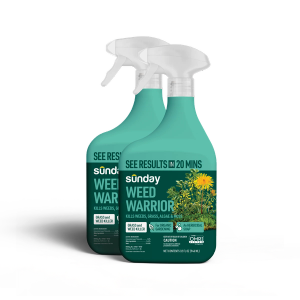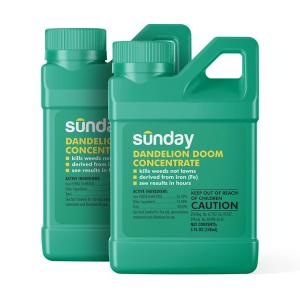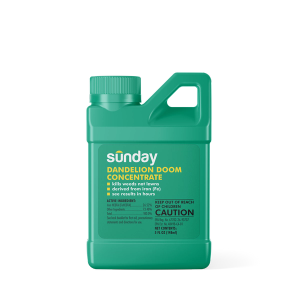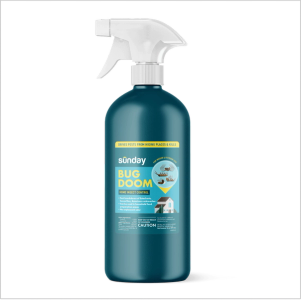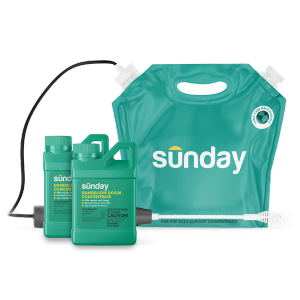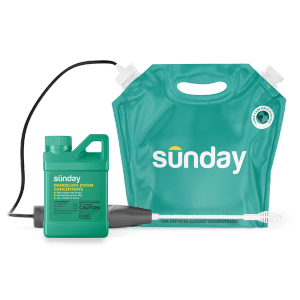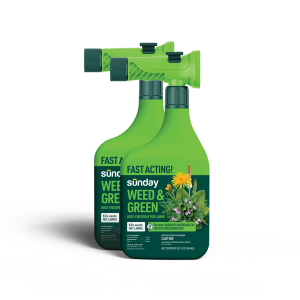Thick grass effectively blocks out much of the sunlight that weeds need to grow, so our strategy is focused on growing a healthy lawn. For weeds that find a way, it’s easier to keep them from spreading if you catch them early before roots grow deep and flowers become seeds.
Dandelions
Nature designed these daisy-like weeds to survive. Their roots can reach up to 10" long, which does not make getting rid of them any easier. This all goes back to one of our favorite things to tell you: The best way to stop them from taking over your yard is to ensure that your lawn’s soil is healthy (we test that for you with the soil kit in your first shipment), because dandelions are attracted to bare spots.
How to get rid of dandelions:
- Water your lawn first to make them come up easier.
- Use a dandelion remover or spade.
- Ensure you take up the entire taproot and try your hardest not to break.
- Spot treat it with Dandelion Doom, our iron-based weed spot treatment.
Crabgrass
Crabgrass is especially troublesome because it invades a lawn and then does not allow other plants to grow. It’s crucial to ensure that you don’t let the seeds of these weeds germinate. Which comes down to maintaining a healthier, strong lawn.
How to get rid of crabgrass:
- Smother it. Cover it with a brick, tile, or a large black tarp to block the weed from getting sunlight. It takes about 4–6 weeks for it to die using this approach. Once it’s dead, remove it and rake the surface where it once was and reseed with quality turf seed.
- Pour boiling water on it. This is a favorite of ours. It’s important to make sure that you just pour the boiling water on the crabgrass as this will kill other plants around the crabgrass.
- Spot-treat it with Weed Warrior, our organic weed spot treatment.
Bindweed
It's a problematic, persistent vining plant that weaves its way across lawns and gardens as well as fences—pretty much anything in its path. Its root system is tough to kill and can survive its vines being cut or treated with herbicide.
How to get rid of bindweed:
- Cut it back.
- Pour boiling hot water on it.
- Spot-treat it with non-toxic, natural herbicides like vinegar or baking soda or Weed Warrior, our organic weed spot treatment.
One kind-of-cool thing about it? Bindweed can be used in lieu of twine when tying and staking plants.
Keep weeds from coming (back)
- Keep your lawn and its soil well fed with the right nutrients so grass grows thick.
- Mow high! Keep grass healthy and thick by mowing high, removing no more than ⅓ of grass blades at any one time. Mowing high will reduce space for weed growth.
- Leave your clippings right where they fall to help nourish your lawn. This is also called grasscycling.
- Fill in the bare patches and overseed to thicken grass and crowd out weeds.
- Be proactive. When weeds are young they are easier to pull and prevent from spreading. Keep an eye out to catch them early. Use a weeding tool (even a screwdriver will work) to pull them out with the root.
- Water deep. Watering less frequently but deeper will promote longer, healthier root growth for your lawn and can dry out more shallow-rooted weeds like crabgrass.
Our approach to weed control
We know not every lawn is the same. You have a unique piece of land. That’s why our plans are tailored to your climate, soil, and lawn. Each plan contains the nutrients your lawn needs to build healthy soil and boost grass growth. We focus on nutrients because we want to help reduce the use of toxic pesticides and harsh chemicals. Plus, growing a strong, healthy lawn is the most effective way to combat weeds and most other lawn issues in the long run.
There are thousands of weeds out there. Some are local to your area; some are widespread and well known. The highest priority weeds to stay on top of in your lawn are ones that spread aggressively or die off mid-season, leaving bare spots behind.
Here are two questions to help you identify how Sunday weed killer products can help with the weeds you find in your lawn:
Is it a broadleaf weed? If your weed has leaves rather than grass like blades, it’s likely a broadleaf weed. Our Dandelion Doom is designed to address broadleaf weeds. To make it even more effective use a trowel to split open the weed’s root.
It is a grassy weed? If your weed has leaves that look like blades of grass, it’s likely a grassy weed. Our Weed Warrior is built to break down grassy weeds from the inside out. It also is effective on many broadleaf varieties. Use carefully; Weed Warrior can’t tell the difference between your grass and a weed.
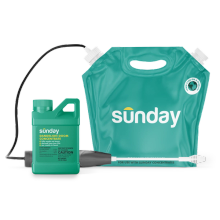
Dandelion Doom Lawn Weed Killer - Starter Pack
- Reusable, easy-fill gallon pouch and battery-powered wand sprayer
- Treats up to 224 sq. ft.
- Kills weeds down to the root
- Safe for use on lawns
- See results within hours!
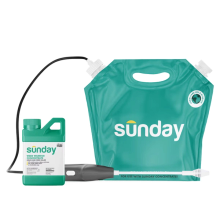
Weed Warrior Weed & Grass Killer - Starter Pack
- Reusable, easy-fill gallon pouch
- Treats up to 224 sq. ft.
- OMRI-listed herbicidal soap
- Not for use in lawns
- See results in 20 minutes!
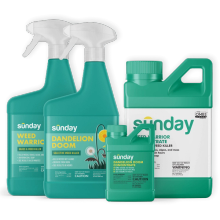
Sunday Ultimate Weeding Kit
- Complete weed solution a comprehensive weed control kit for a weed-free yard
- Wide weed spectrum with control of broadleaf weeds, crabgrass and other grassy weeds, moss, algae, and lichen—even suppresses lawn diseases
- Fast-acting formulas for immediate weed elimination
- Precision weed control with battery-operated Wand Sprayer
- Eco-conscious formulas formulated without harmful chemicals and safety in mind







